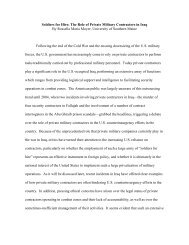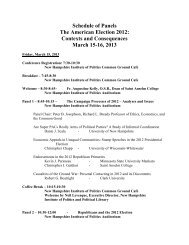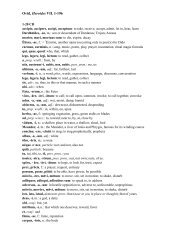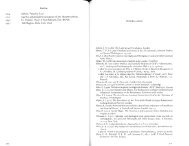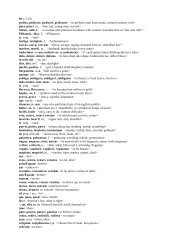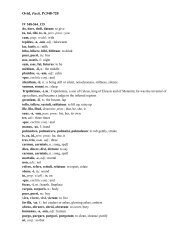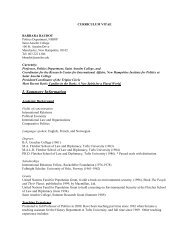Thermophoresis as persistent random walk - Saint Anselm College
Thermophoresis as persistent random walk - Saint Anselm College
Thermophoresis as persistent random walk - Saint Anselm College
Create successful ePaper yourself
Turn your PDF publications into a flip-book with our unique Google optimized e-Paper software.
A.V. Plyukhin / Physics Letters A 373 (2009) 2122–2124 2123<br />
Kramers equation (2) in ph<strong>as</strong>e space to Eq. (3) for the spatial distribution<br />
function f (x, t) = ∫ dv f (x, v, t) (the elimination of the<br />
f<strong>as</strong>t variable v) isnotatrivialstep[15,16], which makes the origin<br />
of the result (4) somewhat obscure. The same perhaps may<br />
be said of the Luttinger’s method of fictitious external fields [17],<br />
which also leads to the result (4) [18,19]. The aim of this Letter is<br />
to formulate a minimal qualitative model of thermophoresis, which<br />
leads to the expression (4) elementary and directly. Besides pedagogical<br />
merits, such model might be useful for numerical modeling<br />
of stoch<strong>as</strong>tic processes at nonuniform temperature.<br />
The model is a slightly generalized version of the well-known<br />
stoch<strong>as</strong>tic process of the continuous <strong>persistent</strong> <strong>random</strong> <strong>walk</strong><br />
[20–22]. In its simplest setting, the process describes a particle<br />
moving in one dimension with fixed speed v suffering occ<strong>as</strong>ionally<br />
a complete reversal of direction. Let f + (x, t) and f − (x, t) be<br />
the probability density for the particle moving to the right and to<br />
the left, respectively. Reversals of velocity are Poisson distributed,<br />
i.e. occurring with a constant rate 1/2τ , so that the probability for<br />
reversal in a time interval dt is dt/2τ . For an infinitesimal time<br />
step one can write<br />
f + (x, t + dt) = f + (x − vdt, t) − f + (x − vdt, t) dt/2τ<br />
+ f − (x + vdt, t) dt/2τ , (6)<br />
and a similar equation for f − (x, t). The corresponding differential<br />
equations read<br />
∂ f +<br />
∂t<br />
=−v ∂ f +<br />
∂x<br />
− f + − f −<br />
,<br />
2τ<br />
∂ f −<br />
∂t<br />
= v ∂ f −<br />
∂x<br />
+ f + − f −<br />
, (7)<br />
2τ<br />
and lead to the telegrapher’s equation for the total density f =<br />
f + + f − ,<br />
∂ 2 f<br />
∂t + 1 2 τ<br />
∂ f<br />
∂t = v2 ∂2 f<br />
∂x 2 . (8)<br />
The same equation holds also for the difference Δ = f + − f − , and<br />
therefore for the components f + and f − separately.<br />
Suppose the particle at t = 0 is at the origin with equal probability<br />
to be in each of the two velocity states,<br />
f ± (x, 0) = 1 2 δ(x), ∂ f ± (x, 0)<br />
=∓ v ∂<br />
δ(x). (9)<br />
∂t 2 ∂x<br />
Here the second initial condition follows from the first one and<br />
Eq. (7). Respectively, the initial conditions for the total density f =<br />
f + + f − are<br />
∂ f (x, 0)<br />
f (x, 0) = δ(x), = 0. (10)<br />
∂t<br />
The corresponding solution of the telegrapher’s equation is well<br />
known [26]. In the long-time limit t ≫ τ , vt ≫ x it coincides exactly<br />
with solution of the Smoluchowski equation<br />
)<br />
f (x, t) ≈ (4π Dt) −1/2 exp<br />
(− x2<br />
(11)<br />
4Dt<br />
with the diffusion coefficient D = τ v 2 . However, unlike the overdamped<br />
Smoluchowski equation (3), Eq.(7) incorporates effects of<br />
inertia of the particle. This advantage, which w<strong>as</strong> recognized and<br />
used beneficially in many previous works (see [22] and references<br />
therein), allows to account for thermophoresis in a particularly<br />
simple way.<br />
To link the model to the problem of thermophoresis, it is natural<br />
to identify v with a typical thermal speed of a Brownian<br />
particle. The choice is ambiguous. For instance, one can set v equal<br />
to the root mean square velocity v rms =〈v 2 〉 1/2 = √ 3kT/m. However,<br />
one can show that in this c<strong>as</strong>e the final result for the thermophoretic<br />
force would differ from Eq. (5) by the factor 3/2 (see<br />
Eq. (16) below). As will be shown, a perfect agreement with the<br />
standard results D T = D/T and F T =−k∇T can be achieved if v<br />
is identified not with v rms but with the most probable speed of a<br />
Brownian particle v mp (for which the Maxwell speed distribution<br />
h<strong>as</strong> a maximum):<br />
v = v mp = √ 2kT/m. (12)<br />
The second parameter of the model 1/τ should be identified with<br />
the friction coefficient γ which appears in the Kramers equation<br />
(2) and in the corresponding Langevin equation ˙v =−γ v + ξ(t).<br />
For nonuniform temperature, the velocity in Eq. (7) is position<br />
dependent, v(x) = √ 2kT(x)/m. In this c<strong>as</strong>e instead of the telegrapher’s<br />
equation (8) one obtains [23]<br />
∂ 2 f<br />
∂t + 1 (<br />
∂ f<br />
2 τ ∂t = ∂2 f<br />
v2 ∂x + 2 v dv ) ∂ f<br />
dx ∂x . (13)<br />
Suppose the temperature gradient is constant, so that T (x) = T +<br />
x ∇T and<br />
v(x) = √ (<br />
2kT(x)/m = v<br />
1 + ∇T<br />
T x ) 1/2<br />
, (14)<br />
where v is the thermal velocity corresponding to the temperature<br />
T , v = √ 2kT/m. ThenEq.(13) reads <strong>as</strong><br />
∂ 2 f<br />
∂t + 1 2 τ<br />
(<br />
∂ f<br />
∂t = v2 1 + ∇T<br />
T<br />
) ∂ 2 x f ∇T<br />
+ v2<br />
∂x2 2T<br />
∂ f<br />
∂x .<br />
For a small gradient (∇T /T )x ≪ 1, the equation is simplified to<br />
the form<br />
∂ 2 f<br />
∂t + 1 ∂ f<br />
2 τ ∂t = ∂2 f<br />
v2 ∂x − F T ∂ f<br />
2 m ∂x , (15)<br />
where the thermophoretic force F T coincides (thanks to the setting<br />
v = √ 2kT/m) with the expression (5) of the standard theory:<br />
F T =− 1 ∇T<br />
mv2 =−k∇T . (16)<br />
2 T<br />
It can be shown that in the long-time limit the solution of Eq. (15)<br />
with the boundary conditions (10) coincides with the solution of<br />
the overdamped equation (3) and describes the drift along the<br />
temperature gradient, superimposed on the diffusion<br />
f (x, t) ≈<br />
1<br />
√ 4π Dt<br />
exp<br />
(− (x − V T t) 2 )<br />
4Dt<br />
(17)<br />
with the drift velocity V T = F T τ /m. Using(16) and recalling D =<br />
τ v 2 ,onegetsV T =−D T ∇T with D T = D/T , thus recovering the<br />
result (4) of the conventional theory.<br />
The <strong>as</strong>ymptotic solution (17) can be obtained <strong>as</strong> follows. After<br />
applying the transformation f (x, t) = φ(x, t) exp(−t/2τ +<br />
F T x/2mv 2 ),Eq.(15) takes the form<br />
∂ 2 φ<br />
∂t 2<br />
= ∂2 φ<br />
v2 ∂x + 1 φ, 2 τ∗<br />
2 (18)<br />
with 1/τ 2 ∗ = 1/4τ 2 − F T /4m 2 v 2 , while the boundary conditions<br />
corresponding to (10) read<br />
φ(x, 0) = δ(x),<br />
∂φ(x, 0)<br />
∂t<br />
= 1<br />
2τ δ(x).<br />
Note that the model makes sense only under the <strong>as</strong>sumption τ∗ 2 ><br />
0, which guarantees the positiveness of f + and f − [25]. Eq.(18) is<br />
the modified telegrapher’s equation whose solution is well known<br />
[26]. Transforming back from φ to f ,theresultcanbewrittenin<br />
the following form<br />
(<br />
f (x, t) = exp<br />
− t<br />
2τ +<br />
F T x<br />
2mv 2 )<br />
(φ 1 + φ 2 + φ 3 ), (19)




